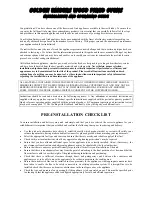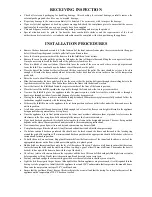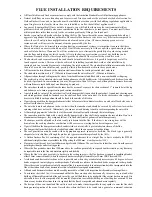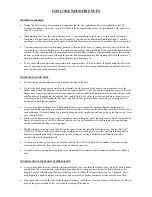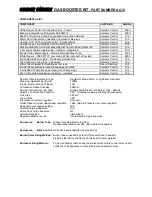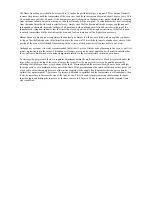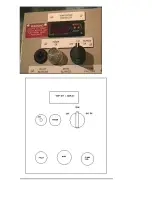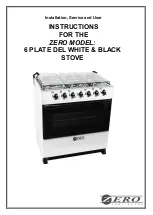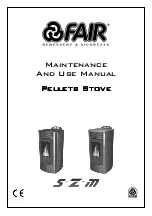
RECEIVING INSPECTION
•
Check all crates and packaging for handling damage. After checking for external damage, carefully remove the
external packaging and check for any ‘concealed’ damage.
•
Report any damage to the carrier immediately it is detected. The carrier may wish to inspect the damage.
•
If gas or electrical appliance or back up systems are supplied, check the compliance plates to ensure that the correct
appliance for the specified gas or power supply have been supplied.
•
Care and diligence must be exercised when unpacking, assembling and moving the product.
•
Special attention must be paid to fire hazards from combustible surfaces and the requirements of the local
authorities and relevant safety or standards authorities must be complied with when positioning the appliance.
INSTALLATION PROCEDURES
•
Remove the base frame and assemble it. At the lower end of the front and rear frames place the cross members in the upper
holes (110mm from the ground) so that a pallet trolley can fit under them.
•
Leave the front top cross member of the frame so that the forklift can lower its tines.
•
Remove the oven from the pallet by getting the fork under the front of the metal base and lifting the oven up several inches.
It may be necessary to break the front board of the pallet away to achieve this
•
Place two blocks of some sort (about 150mm thick) near the centre of the oven on each side to act as pivot points and
lower the fork. The oven should now be balance some 150mm above the pallet.
•
Place the tines of the fork under the steel base and lift the oven clear of the pallet. The tines should be set so as to be close
enough to fit inside the frame and should not be inserted further back than about two inches in front of the temperature
probe hole.
•
Raise the oven to about 950mmm above the ground.
•
Slide the frame under the base and slowly lower the oven so that the locating bolts pass through the matching holes in the
top side members of the frame. Then fasten these bolts to the frame with the nuts and washers.
•
Lower the tines of the forklift and fasten the top cross member of the front of the frame in position.
•
Place the tines of the forklift, spread wide as possible, through the frame below the two top cross members.
•
Now use the forklift to place the appliance inside the premises onto a stable level surface, whether this is through a
doorway or through a window from which the pane of glass has been removed.
•
If using the turning frame to achieve installation through standard 900mm doorways please carefully read and follow the
instructions supplied separately with the turning frame.
•
Either use the forklift to move the appliance to its set down position or place a pallet trolley under the frame and move the
unit into position.
•
At all times ensure that the appliance is only lifted enough to be clear of the floor excess height will result in the appliance
being unstable during movement as it is top heavy.
•
Once the appliance is in its final position remove the lower cross members and secure them at ground level or secure the
side frames to the floor using dyna bolts and completely remove the front cross member.
•
If gas back has been purchased, this should be fastened to the frame in the designated position. The exact fixing method
depends on the class of burner purchased and is detailed in the accompanying instructions.
•
Now connect any gas and power lines and test and commission any burners fitted.
•
Your plumber or gas fitter should now fit any flues and exhaust ducts and adjust the damper settings.
•
If a deluxe surround has been purchased this should now be laced around the frame and fastened to the locating ring
around the girth of the appliance. If a turret surround has been purchased the upper portion should be fitted above the lower
surround and fastened in position.
•
To build the outer base enclosure, drop plumb line marks from the front corners of the tunnel and then draw a circle of the
appropriate diameter on the floor, which passes through the two plumb points.
•
Build a brick or other material base up to the level of the render of the oven. Take care at all times to ensure that there is no
contact between the bricks and the steel base of the oven. Keep a gap of at least 10mm at all times. Then render the base (if
desired) to line up with the dome in line with the top of the bricks.
•
Cut a fine v joint in at the union between the top render and the base. This can be filled with polyfilla high stress or similar
before painting or tiling. Finally insert the granite mantle and decorate to your own taste.
•
Seal any joints and sponge the colour coating provided over the sealed joints so that they are not visible.
•
Light the first fire or ignite the gas burner. Although Golden Embers appliances are pre-seasoned, it is still required that the
heat up cycle be progressive. Initially heat the appliance to around 120
o
C and maintain that temperature for around 4 hours.
Then raise the temperature in steps of 50
o
C each four hours.
•
Ensure that the gas flame (if any) does not fire directly into the oven wall and that the startup fire is kept in the centre of the
appliance until a temperature of 300
o
C has been reached
Summary of Contents for Wood Fired Ovens
Page 14: ...GOLDEN EMBERS AC11 CLASS 1 GAS WOOD FIRE GAS TRAIN SCHEMATIC AND LEGEND ...
Page 17: ......
Page 18: ......

